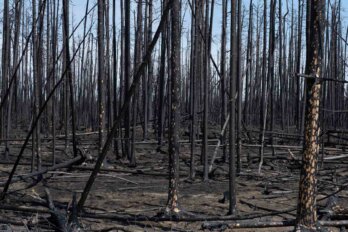Sometime in the early 2000s—no one knows exactly when—“climate change” overthrew “global warming” in a lexical coup d’état. The deposed term had been in power since 1988, when NASA scientist James Hansen’s historic congressional testimony made “global warming” a household term. Hansen paired it with “greenhouse effect” (over a century old by then but languishing in obscurity), a mutual signal boost that fired the world’s imagination for approximately one hot minute.
“Global warming” was an undeniable improvement over its predecessor, “inadvertent climate modification,” but in the end, it proved too narrow minded for the twenty-first century. The image of a uniformly heating planet failed to evoke the full range of climate impacts coming down the pike. Earth wasn’t just warming; it was also getting wetter in some spots, drier in others, stormier almost everywhere, and even, in some places, colder.
“Climate change” has its own problems. Efficient, yes. Two words say it all. But after all these years, it’s become the antithesis of fresh language, an almost guaranteed eye glazer. It’s also gathered baggage, much like its cousin “woke,” carrying a strong whiff of finger-wagging sanctimony.
It’s too bad “global weirding” never caught on. That term, coined in the early 2000s to evoke the increasingly strange weather our carbonated atmosphere was starting to churn out, was a lot more fun. It did attract a cult following (fans include acclaimed climate scientist Katharine Hayhoe and New York Times columnist Thomas L. Friedman) but remains unheard of in most circles. Still, devotees of “global weirding” can take some consolation: as weather gets weirder, so does the language we use to describe it.
Back when “climate change” took over—when the atmospheric concentration of carbon dioxide was well below 400 parts per million and you could go all summer without smelling wildfire smoke—hardly anyone had heard of a “polar vortex” or an “atmospheric river”; no one knew the difference between a “heat wave” and a “heat dome.”
The term “heat dome”—high pressure in the mid to upper atmosphere pressing a vast bubble of hot air over the earth’s surface—was coined years ago, but it gained new currency in 2011 amidst an excruciating stretch of hot weather in the US. I first heard it ten years later, when a famous heat dome smothered parts of British Columbia. In June 2021, Vancouver’s schools closed due to heat for the first time in the city’s history; more than 600 people died; over 1 billion intertidal sea creatures baked to death; the BC village of Lytton set a Canadian heat record of 49.6 degrees before burning to the ground.
Four months later, biblical rains tore apart the highways and train tracks connecting Vancouver to the outside world, leaving the city cut off and much of the province sundered by landslides and floods. This introduced me to the term “atmospheric river.” The name says it all: a long, narrow band of water vapour in the sky that starts above warm ocean (near Hawaii in this case) and cools as it flows over land, where the vapour condenses and falls as torrential rain. While the term was coined in 1994, there’s the nineteenth-century Scottish word “thunderplump,” which is when a sudden heavy downpour comes out of nowhere and drenches you in seconds. This one hasn’t gone viral yet.
As with heat domes, the reason we know about atmospheric rivers today isn’t that they’re new. It’s that they’re growing more frequent and intense. The same is true of many of the names that sound new to non-meteorologists. Take “bomb cyclone”: a heavy, rapid-forming winter storm caused when a cold, northern front collides with a warm southern front, resulting in a sudden massive drop in air pressure (twenty-four millibars in twenty-four hours is the going definition). This one-day incubation period—known as “bombogenesis”—isn’t a novel phenomenon, nor are these terms. But bomb cyclones form more often today than ever, thanks to you-know-what.
At the opposite end of the spectrum is the “flash drought.” Named in the early 2000s, flash droughts develop in weeks or months as opposed to the usual gestation period of years or even decades. If a flash drought envelops a forest, it might not be long before you see a pyrocumulus cloud; these arise when a wildfire burns so hot that any moisture from its fuel rises as vapour and re-forms as a huge cloud high above the fire—something that happens only in the most intense wildfires, which we’re seeing more of than ever. In even rarer cases (but again, less rare than before), the winds generated by a pyrocumulus cloud could spin off that most Hollywood of global weirding phenomena, a “firenado.”
When a flash drought hits agricultural landscapes, you get “heatflation.” This one’s brand new, coined in 2022 by Grist writer Kate Yoder to name the relationship between drought and grocery bills. Harvests throughout western North America have been hammered by successive record droughts over the past five years, but you no longer have to live under a heat dome to pay for them. The same global supply chains that once buffered everyone but farmers from local weather blips now expose the majority to agricultural disasters across continents. Drought is hitting olive production in the Mediterranean and cocoa harvests in West Africa; it’s punishing coffee growers in Vietnam and Brazil, where sugar and soy plantations are also drying out. This costs everyone, and it’s only getting started. A recent study by the journal Communications Earth and Environment predicted heatflation could further raise global food prices by up to 3 percent by 2035.
Of course, the impact of climate change goes well beyond heat and agriculture. Just ask the home insurance industry. That’s why the terms “climateflation” and “fossilflation” are starting to do the rounds as well.
These words, and many more like them (I haven’t even got to “thundersnow” or “corn sweat”), are proliferating. New ones appear every season. That in itself signals something that’s become unusual: attention to the natural world. But there’s a deeper meaning too. For all its diversity, this new climate vocabulary evokes a common set of attributes: acceleration, intensity, violence. A lurch to extremes. The word “change” is too ambivalent for something that so often leads to calamity, and so “climate change” is itself giving way to “climate crisis” or “climate emergency” instead.
It all goes well beyond weather. Geopolitical storms are intensifying too. On every scale, society is being pulled to extremes by forces beyond our control. “Global weirding” captures our cultural climate as well as the atmospheric one. Is that a coincidence? Should we be surprised that, as the atmosphere heats up, so do human relations? These tempests are familiar, and we have names for them already: disinformation, tyranny, collateral damage. But those twentieth-century terms don’t quite apprehend the modern variants we’re dealing with today. Hence tweaks and updates: Deepfake. Broligarchy. Polycrisis.
New circumstances require new vocabulary. We have to know how old threats have evolved and why—if we want to overcome them. That’s why the language matters.
The other side knows this too. Climate deniers and aspiring dictators alike are inventing their own terminology and have a special talent for using ours against us. Fake news. Eco-radical. Freedom. My body, my choice. This kind of language, in service of wealth or power or the fossil fuel industry, obscures reality instead of illuminating it. As Steve Bannon, the far-right influencer and former chief strategist to Donald Trump, famously put it, the point is to “flood the zone with shit.” He was describing the Trumpian strategy of inundating the news cycle with chaos in order to overwhelm journalists; that in turn makes it harder for the public to distinguish genuine crises like climate change from manufactured spectacles. Add that kind of flood to the new climate lexicon.
For people with hidden intentions, accurate language is always a threat. It exposes them. As playful as the new climate jargon can be, in this respect, it’s also deadly serious. It helps us comprehend reality. Atmospheric rivers, bomb cyclones, heatflation, and pyrocumulus clouds are not the product of a hoax. They’re reminders that human affairs are intimately tied to the non-human world, that nature herself is a protagonist in our drama and not just the stage on which we act.
In that sense, these new terms add up to their own kind of evidence: not only are we changing the weather but the weather’s changing us.
With thanks to the Trottier Foundation for helping The Walrus publish writing on climate change and the environment.




